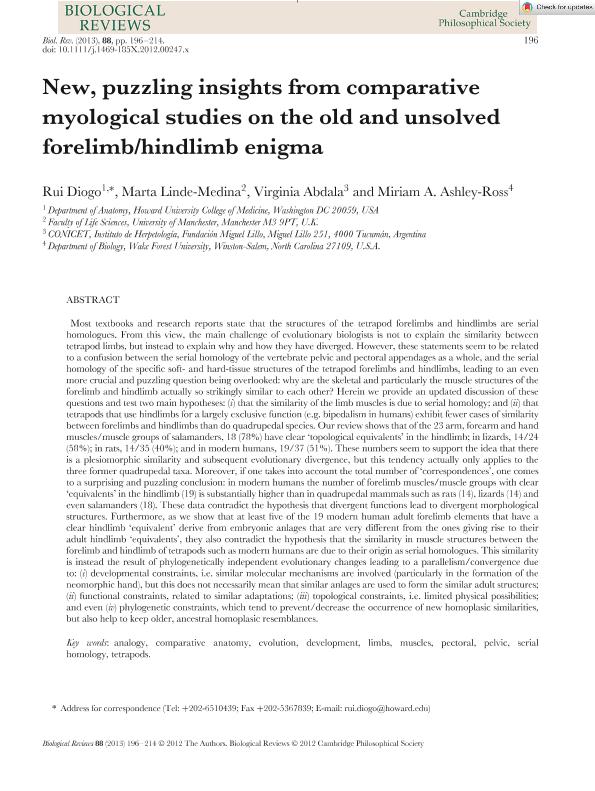Artículo
New, puzzling insights from comparative myological studies on the old and unsolved forelimb/hindlimb enigma
Fecha de publicación:
09/2012
Editorial:
Wiley
Revista:
Biological Reviews
ISSN:
1464-7931
Idioma:
Inglés
Tipo de recurso:
Artículo publicado
Clasificación temática:
Resumen
Most textbooks and research reports state that the structures of the tetrapod forelimbs and hindlimbs are serial homologues. From this view, the main challenge of evolutionary biologists is not to explain the similarity between tetrapod limbs, but instead to explain why and how they have diverged. However, these statements seem to be related to a confusion between the serial homology of the vertebrate pelvic and pectoral appendages as a whole, and the serial homology of the specific soft- and hard-tissue structures of the tetrapod forelimbs and hindlimbs, leading to an even more crucial and puzzling question being overlooked: why are the skeletal and particularly the muscle structures of the forelimb and hindlimb actually so strikingly similar to each other? Herein we provide an updated discussion of these questions and test two main hypotheses: (i) that the similarity of the limb muscles is due to serial homology; and (ii) that tetrapods that use hindlimbs for a largely exclusive function (e.g. bipedalism in humans) exhibit fewer cases of similarity between forelimbs and hindlimbs than do quadrupedal species. Our review shows that of the 23 arm, forearm and hand muscles/muscle groups of salamanders, 18 (78%) have clear ‘topological equivalents' in the hindlimb; in lizards, 14/24 (58%); in rats, 14/35 (40%); and in modern humans, 19/37 (51%). These numbers seem to support the idea that there is a plesiomorphic similarity and subsequent evolutionary divergence, but this tendency actually only applies to the three former quadrupedal taxa. Moreover, if one takes into account the total number of ‘correspondences’, one comes to a surprising and puzzling conclusion: in modern humans the number of forelimb muscles/muscle groups with clear ‘equivalents’ in the hindlimb (19) is substantially higher than in quadrupedal mammals such as rats (14), lizards (14) and even salamanders (18). These data contradict the hypothesis that divergent functions lead to divergent morphological structures. Furthermore, as we show that at least five of the 19 modern human adult forelimb elements that have a clear hindlimb ‘equivalent’ derive from embryonic anlages that are very different from the ones giving rise to their adult hindlimb ‘equivalents’, they also contradict the hypothesis that the similarity in muscle structures between the forelimb and hindlimb of tetrapods such as modern humans are due to their origin as serial homologues. This similarity is instead the result of phylogenetically independent evolutionary changes leading to a parallelism/convergence due to: (i) developmental constraints, i.e. similar molecular mechanisms are involved (particularly in the formation of the neomorphic hand), but this does not necessarily mean that similar anlages are used to form the similar adult structures; (ii) functional constraints, related to similar adaptations; (iii) topological constraints, i.e. limited physical possibilities; and even (iv) phylogenetic constraints, which tend to prevent/decrease the occurrence of new homoplasic similarities, but also help to keep older, ancestral homoplasic resemblances.
Palabras clave:
Comparative Anatomy
,
Development
,
Muscles
,
Limbs
Archivos asociados
Licencia
Identificadores
Colecciones
Articulos(CCT - NOA SUR)
Articulos de CTRO.CIENTIFICO TECNOL.CONICET - NOA SUR
Articulos de CTRO.CIENTIFICO TECNOL.CONICET - NOA SUR
Citación
Diogo, Rui; Linde Medina, Marta; Abdala, Virginia Sara Luz; Ashley Ross, Miriam A.; New, puzzling insights from comparative myological studies on the old and unsolved forelimb/hindlimb enigma; Wiley; Biological Reviews; 88; 1; 9-2012; 196-214
Compartir
Altmétricas




